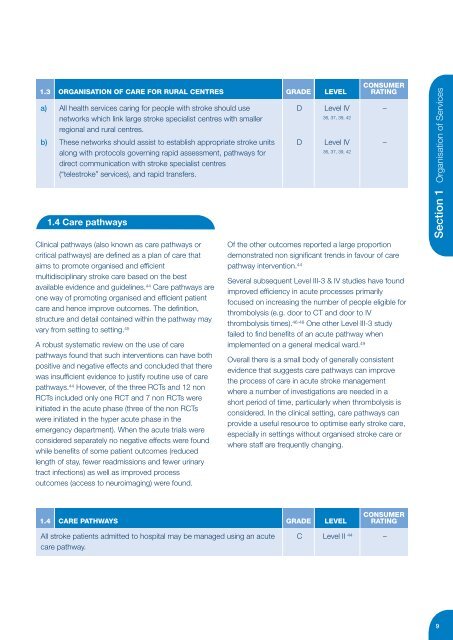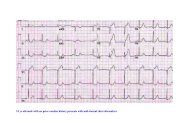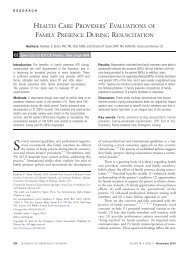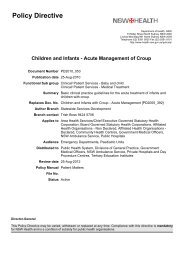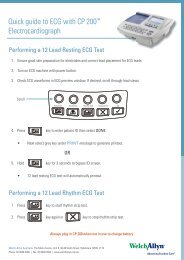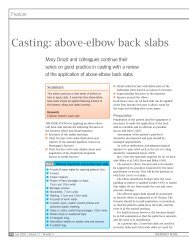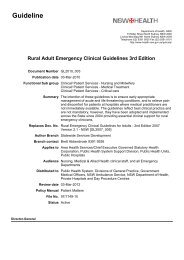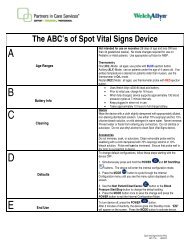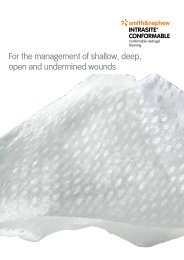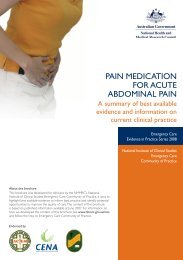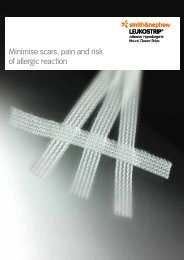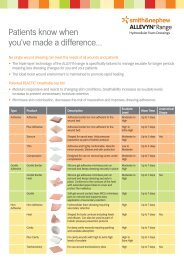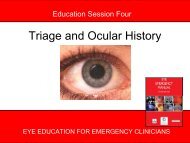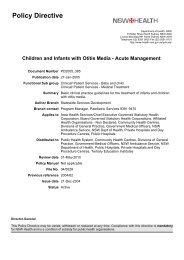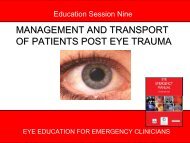Clinical Guidelines for Acute Stroke Management - Living on the EDge
Clinical Guidelines for Acute Stroke Management - Living on the EDge
Clinical Guidelines for Acute Stroke Management - Living on the EDge
You also want an ePaper? Increase the reach of your titles
YUMPU automatically turns print PDFs into web optimized ePapers that Google loves.
CONSUMER<br />
1.3 ORGANISATION OF CARE FOR RURAL CENTRES GRADE LEVEL RATING<br />
a) All health services caring <str<strong>on</strong>g>for</str<strong>on</strong>g> people with stroke should use D Level IV –<br />
networks which link large stroke specialist centres with smaller<br />
36, 37, 39, 42<br />
regi<strong>on</strong>al and rural centres.<br />
b) These networks should assist to establish appropriate stroke units D Level IV –<br />
al<strong>on</strong>g with protocols governing rapid assessment, pathways <str<strong>on</strong>g>for</str<strong>on</strong>g><br />
36, 37, 39, 42<br />
direct communicati<strong>on</strong> with stroke specialist centres<br />
(“telestroke” services), and rapid transfers.<br />
1.4 Care pathways<br />
<str<strong>on</strong>g>Clinical</str<strong>on</strong>g> pathways (also known as care pathways or<br />
critical pathways) are defined as a plan of care that<br />
aims to promote organised and efficient<br />
multidisciplinary stroke care based <strong>on</strong> <strong>the</strong> best<br />
available evidence and guidelines. 44 Care pathways are<br />
<strong>on</strong>e way of promoting organised and efficient patient<br />
care and hence improve outcomes. The definiti<strong>on</strong>,<br />
structure and detail c<strong>on</strong>tained within <strong>the</strong> pathway may<br />
vary from setting to setting. 45<br />
A robust systematic review <strong>on</strong> <strong>the</strong> use of care<br />
pathways found that such interventi<strong>on</strong>s can have both<br />
positive and negative effects and c<strong>on</strong>cluded that <strong>the</strong>re<br />
was insufficient evidence to justify routine use of care<br />
pathways. 44 However, of <strong>the</strong> three RCTs and 12 n<strong>on</strong><br />
RCTs included <strong>on</strong>ly <strong>on</strong>e RCT and 7 n<strong>on</strong> RCTs were<br />
initiated in <strong>the</strong> acute phase (three of <strong>the</strong> n<strong>on</strong> RCTs<br />
were initiated in <strong>the</strong> hyper acute phase in <strong>the</strong><br />
emergency department). When <strong>the</strong> acute trials were<br />
c<strong>on</strong>sidered separately no negative effects were found<br />
while benefits of some patient outcomes (reduced<br />
length of stay, fewer readmissi<strong>on</strong>s and fewer urinary<br />
tract infecti<strong>on</strong>s) as well as improved process<br />
outcomes (access to neuroimaging) were found.<br />
Of <strong>the</strong> o<strong>the</strong>r outcomes reported a large proporti<strong>on</strong><br />
dem<strong>on</strong>strated n<strong>on</strong> significant trends in favour of care<br />
pathway interventi<strong>on</strong>. 44<br />
Several subsequent Level III-3 & IV studies have found<br />
improved efficiency in acute processes primarily<br />
focused <strong>on</strong> increasing <strong>the</strong> number of people eligible <str<strong>on</strong>g>for</str<strong>on</strong>g><br />
thrombolysis (e.g. door to CT and door to IV<br />
thrombolysis times). 46-48 One o<strong>the</strong>r Level III-3 study<br />
failed to find benefits of an acute pathway when<br />
implemented <strong>on</strong> a general medical ward. 49<br />
Overall <strong>the</strong>re is a small body of generally c<strong>on</strong>sistent<br />
evidence that suggests care pathways can improve<br />
<strong>the</strong> process of care in acute stroke management<br />
where a number of investigati<strong>on</strong>s are needed in a<br />
short period of time, particularly when thrombolysis is<br />
c<strong>on</strong>sidered. In <strong>the</strong> clinical setting, care pathways can<br />
provide a useful resource to optimise early stroke care,<br />
especially in settings without organised stroke care or<br />
where staff are frequently changing.<br />
Secti<strong>on</strong> 1 Organisati<strong>on</strong> of Services<br />
CONSUMER<br />
1.4 CARE PATHWAYS GRADE LEVEL RATING<br />
All stroke patients admitted to hospital may be managed using an acute C Level II 44 –<br />
care pathway.<br />
9


